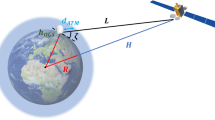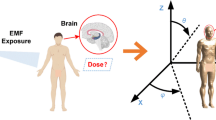Abstract
In this work, propagation loss models for indoor environment are presented. The directive channel propagation loss in indoor environment at frequency bands of 3.3 GHz with a channel bandwidth of 200 MHz and 5.5 GHz band with 320 MHz bandwidth is measured using vertical polarizations where a set of directive panel antennas and a network analyzer are used in the measurement campaign. It is noticed that, the propagation loss can be modelled by two slopes propagation model giving a rise to two propagation zones. The first zone of propagation is almost free space propagation zone while generally; the second zone has a higher deviation from the mean value of propagation loss. A new Hypo-Rayleigh distribution is proposed to model the channel induced fading in the second zone of the propagation zones.

















Similar content being viewed by others
References
Roozbahani, M. G., Jedari, E., & Shishegar, A. A. (2008). A new link-level simulation procedure of wideband MIMO radio channel for performance evaluation of indoor WLANS. Progress in Electromagnetics Research, 83, 13–24.
Gomez, T. J., Saez de Adana, F., & Gutierrez, O. (2009). The application of ray-tracing to mobile localization using the direction of arrival and received signal strength in multipath indoor environments. Progress in Electromagnetics Research, 91, 1–15.
Blas Prieto, J., Fernández, P., Lorenzo, R. M., Abril, E. J., Mazuelas, S., Franco, S. M., et al. (2008). A model for transition between outdoor and indoor propagation. Progress in Electromagnetics Research, 85, 147–167.
Bahillo, A., & Bullido, D. (2008). A model for transition between outdoor and indoor propagation. Progress in Electromagnetics Research, 85, 147–167.
Yarkoni, N., & Blaunstein, N. (2006). Prediction of propagation characteristics in indoor radio communication environment. Progress in Electromagnetics Research, 59, 151–174.
Howitt, L., & Khan, M. S. (2010). A mode based approach for characterizing RF propagation in conduits. Progress in Electromagnetics Research B, 20, 49–64.
Tummala, D. (2005). Indoor propagation modelling at 2.4 GHz for IEEE 802.11 networks. M.Sc Thesis, University of North Texas, December 2005.
Masson, Emilie, et al. (2009). Radio wave propagation in arched cross section tunnels—Simulations and measurements. Journal of Communications, 4(4), 276–283.
Kjeldsen, E., & Hopkins, M. (2006). An experimental look at RF propagation in narrow tunnels. Atlanta, GA: Scientific Research Corporation (SRC).
Barbiroli, M., Carciofi, C., Degli Esposti, V., Fuschini, F., Grazioso, P., Guiducci, D., et al. (2010). Characterization of WiMAX propagation in microcellular and picocellular environments. In 2010 Proceedings of the fourth European conference on antennas and propagation (EuCAP), Barcelona, Spain, pp. 1–5.
Zaballos, A., Corral, G., Carné, A., & Pijoan, J. L. (2004). Modeling new indoor and outdoor propagation models for WLAN. www.salle.url.edu/~zaballos/opnet/OPNET2004b.pdf
Gorce, J. M., Runser, K., & de la Roche, G. (2005) FDTD based efficient 2D simulations of Indoor propagation for wireless LAN. www. katia.runser.free.fr/Fichiers/GORCE_IMACS_FINAL.pdf
Nerguizian, C., Despins, C. L., Affes, S., & Djadel, M. (2005). Radio-channel characterization of an underground mine at 2.4 GHz. IEEE Transactions on Wireless Communications, 4(5), 2441–2453.
Poutanen, J., Haneda, K., Salmi, J., et al. (2009). Analysis of radio wave propagation from an indoor hall to a corridor. IEEE Antennas and Propagation Symposium/USNC/URSI, 1–6, 2683–2686.
Mao, X. H., Lee, Y. H., & Ng, B. C. (2010). Propagation modes and temporal variations along a lift shaft in UHF band. IEEE Transactions on Antennas and Propagation, 58(8), 2700–2709.
Ahmed, B. T., Campillo, D. F., & Campos, J. L. M. (2012). Short range propagation model for a very wideband directive channel at 5.5 GHz band. Progress in Electromagnetics Research, 130, 319–346.
Ahmed, B. T., Hidalgo, C. A. N., & Campos, J. L. M. (2014). Narrowband short range directive channel propagation loss in indoor environment at three frequency bands. Wireless Personal Communications, 78, 507–520.
Author information
Authors and Affiliations
Corresponding author
Appendix
Appendix
The Hypo-Rayleigh induced fading is due to a strong direct ray between the transmitting antenna and the receiving one with lower power indirect rays as shown in Fig. 18 which for simplicity shows only two indirect rays. If the indirect rays diminish, the no fading case will be got.
The PDF of a Rayleigh distribution is given by:
The CDF of the Rayleigh distribution is given by:
Subsisting r by (x-a), the PDF of the proposed new distribution (Ahmed Distribution) is given by:
The CDF of the proposed new distribution (Ahmed Distribution) is given by:
where a is the deviation parameter.
CDF will be 0 when (x−a) is set to zero mean while it will be one when (x−a) is set to infinity.
This distribution is reduced to the Rayleigh distribution one when a = 0 and it reduces to Hyper-Rayleigh distribution when a is negative. From 4 it can be noticed that, the CDF value will be 1 when (x−a) goes to infinity.
Figures 19, 20 and 21 present the PDF of the Hypo-Rayleigh distribution for different values of the parameter (a) for σ of 0.4, 0.8 and 1.2 respectively.
Figures 22, 23 and 24 present the CDF of the Hypo-Rayleigh distribution for different values of the parameter (a) for σ of 0.4, 0.8 and 1.2 respectively. It can be seen that maximum value of CDF is 1.
Figure 25 shows the CDF of the Hypo-Rayleigh, Rayleigh and Hypo-Rayleigh distributions with (a = −0.05, 0 and 0.05 respectively) when σ = 0.8.
The distribution reduced to the no fade case when with a = 1 when σ = 0.0. Figure 26 shows the CDF for this case.
Rights and permissions
About this article
Cite this article
Ahmed, B.T., Plaza, M.E. A New Hypo-Rayleigh Distribution for Short Range Wide-Band Directive Indoor Channel Fading Modeling at 3.3 and 5.5 GHz Bands. Wireless Pers Commun 85, 1905–1923 (2015). https://doi.org/10.1007/s11277-015-2879-z
Published:
Issue Date:
DOI: https://doi.org/10.1007/s11277-015-2879-z













